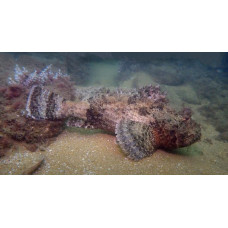Latin name
Scorpaena plumieri
Other name
Scorpaena plumieri
Identification
The spotted scorpionfish has a robust body. Toxin glands attached to the spines of the dorsal fin serve as a defence against predators. They have a suborbital ridge made up of two or three suborbital bones, each with one or two protuberances. They have fleshy feathers called "antennae" under their eyes, with flaps of skin around the chin and head. The upper jaw extends beyond the eyes and the mouth is at the end. It has a well-developed occipital fossa.
Features of fish fins
This species has broad fan-shaped pectoral fins, the dorsal fin is solid and serrated and the caudal fin is truncated. The dorsal fin has 12 spines, nine soft rays and the pectoral fin has 18-21 rays.
Fish colouring
The colouration of these fish varies from brown to black on a light background, the areas in front of the caudal fin are very pale. There are dark spots on the head and the belly is orange-red. The fins have dark stripes and blotches on a pale background, but most often with green spots. The caudal fin has dark stripes in the middle and near the end. The pectoral fins are white on the inside. When threatened, the pectoral fins become elongated and brightly coloured.
Distribution
They live in the western Atlantic Ocean, from Bermuda to Massachusetts, and from the northern Gulf of Mexico to southern Brazil. They are also found in the eastern Atlantic, around Ascension Island and St Helena.
Habitat
Spotted scorpionfish live on shallow coral reefs and rocky areas, usually at depths of 5-55 metres (16-180 feet).
Size
It is the largest scorpionfish in the Atlantic and Caribbean; the largest recorded size was 45 centimetres (18 inches) long, although on average this species grows from 18 to 36 centimetres (7.1 to 14.2 inches) and can weigh 1.55 kilograms (3.4 pounds).
Behavior
They use kinematic timing tactics, a type of technique that focuses their attention on the prey and its general position based on the victim's body position. They only attack when the victim's position is likely to be favourable for an attack. In addition to ambush predation, kinematic timing allows them to wait for the best prey option.
Food and feeding habits
Scorpaena plumieri does not hunt actively as it is an ambush predator, camouflaging itself to approach its prey. It uses its large mouth like a vacuum cleaner and quickly sucks up its prey, which includes fish and crustaceans.
Reproduction
The reproduction of these animals is not well understood, but it is known that they are oviparous, with the female laying transparent or greenish eggs.
Fishing
This species is not commercially important and can sometimes be found in the aquarium trade.
Relationship with a person
The spines on the back of the fish secrete venom, so these animals can be dangerous to humans. The venom is haemorrhagic, hemolytic and proteolytic, and contains cardiotoxins that reduce blood pressure, heart rate and respiration. Symptoms include excruciating pain at the site, accompanied by swelling, erythema and sometimes skin necrosis. Other symptoms include adenopathy, nausea, vomiting, restlessness, malaise, sweating, tachycardia, arrhythmias, respiratory distress and severe arterial hypotension. The main treatment for pain is to immerse the affected limb in hot water (45-50°C) until the pain subsides.
| Classification | |
| Phylum | Chordata |
| Class | Actinopterygii |
| Squad | Scorpaeniformes |
| Family | Scorpaenidae |
| Genus | Scorpaena |
| Species | S. plumieri |
| Features | |
| Conservation status | Least Concern |
| Habitat | Bottom |
| Life span, years | No information |
| Maximum body weight, kg | 1,55 |
| Maximum length, cm | 45 |
| Sailing speed, m/s | No information |
| Threat to people | Not edible |
| Way of eating | Predator |
Spotted scorpionfish
Tags: spotted scorpionfish



